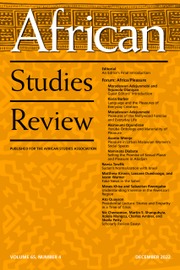Rose A. Sackeyfio’s 2024 book, African Women Narrating Identity: Local and Global Journey of the Self, offers a profound exploration of African women’s experiences as articulated through the works of prominent African women writers, both on the continent and in the diaspora. The book is divided into two distinct parts: “Feminist Perspectives from African Contexts” and “Voices from the Diaspora in African Women’s Fiction.” Sackeyfio highlights the remarkable achievements of African women writers, particularly in their resistance to various barriers as they navigate postcolonial realities and globalized worlds. The book draws upon a diverse array of texts from well-known authors such as Nawal El Saadawi, Muthoni Likimani, Amma Darko, Leila Aboulela, NoViolet Bulawayo, Igiaba Scego, and Chimamanda Ngozi Adichie. These narratives, across their varied contexts, offer insight into the struggles and victories of African women and their communities, allowing readers to engage deeply with their complex lives and histories.
What sets Sackeyfio’s work apart is her ability to transcend the traditional binary narratives of women’s oppression within patriarchal systems. She expands her analysis to encompass broader transnational issues, including themes such as immigration, global mobility, and the diasporic experience. By focusing on these topics, Sackeyfio emphasizes the importance of “herstories,” a term she uses to denote women’s narratives told from their own perspectives. Drawing from over forty years of research and travel in West Africa, Sackeyfio possesses an epistemic privilege allowing her to articulate the nuances of African women’s resistance, empowerment, and agency in local and global settings. The introduction (3–27) is particularly detailed and could function as a stand-alone chapter, laying a strong foundation for the subsequent analyses. The discussions here introduce various writers, some of whom do not appear in the later sections of the book, further showcasing the broad range of Sackeyfio’s scholarship.
In the first part, Sackeyfio navigates through texts that deal with the intersectionality of patriarchy, religion, and politics in African societies. She begins with Nawal El Saadawi’s Woman at Point Zero and God Dies by the Nile, examining how Egyptian society constrains women (Chapter One). The reader is then transported to Botswana through Bessie Head’s Maru (Chapter Two), where Sackeyfio dissects issues of intra-ethnic discrimination, racial exclusion, and gender oppression. Muthoni Likimani’s Passbook Number F.47927 complements the previous themes by exploring Kenyan women’s resilience during the nationalist movement. In Chapter Four, which ends the first part, the theme of exploitation and family disruption is highlighted through Amma Darko’s Faceless, with a focus on how women and children survive against great odds, while still exhibiting resistance and agency.
The second part shifts focus to diasporic narratives. In Chapter Five, Sackeyfio turns to Leila Aboulela’s The Translator and Minaret, exploring how diasporic and Islamic identities shape the lives of Muslim women as they navigate their existence in non-Muslim contexts. Here, Sackeyfio uncovers cultural transformation, religious silencing, and the authenticity of women’s voices in overcoming these challenges. NoViolet Bulawayo’s We Need New Names (Chapter Six) delves into the identity crises of the young protagonist, Darling, who leaves Zimbabwe for America. Bulawayo’s narrative, as Sackeyfio notes, captures the complexities of childhood and the dislocation experienced by African youth in globalized contexts. Igiaba Scego’s Adua (Chapter Seven) explores the transnational encounter in Italy, detailing the degrading experiences of Somali women. Sackeyfio’s analysis of this novel touches on the violence inflicted on female bodies and the regulation of women’s sexuality in Somali culture. The final chapter examines Chimamanda Ngozi Adichie’s Americanah, where Sackeyfio critiques the concept of Afropolitanism. While Afropolitanism is often viewed as a celebration of African immigrants’ assimilation into Western life, Sackeyfio argues—through Adichie’s work—that this view is problematic and overlooks the complexities and disjointed experiences of African immigrants, especially women like Ifemelu.
In conclusion, Sackeyfio’s work offers more than a literary analysis. It is a tapestry of African women’s experiences, weaving together themes of identity, hybridity, global mobility, and the struggle for agency. Through her exploration of both African and diasporic writers, Sackeyfio creates a narrative that is expansive yet deeply personal, allowing readers to see how African women’s stories transcend borders and cultural constraints. Her book emphasizes that these women’s voices are not just acts of resistance but also tools of empowerment and historical agency. Sackeyfio’s analysis makes it clear that African women’s literature is in constant conversation, negotiating the complexities of postcolonialism, modernity, and globalization. This review confirms that Sackeyfio’s African Women Narrating Identity is a must-read for anyone interested in African literature, feminist theory, or the diasporic experience.


